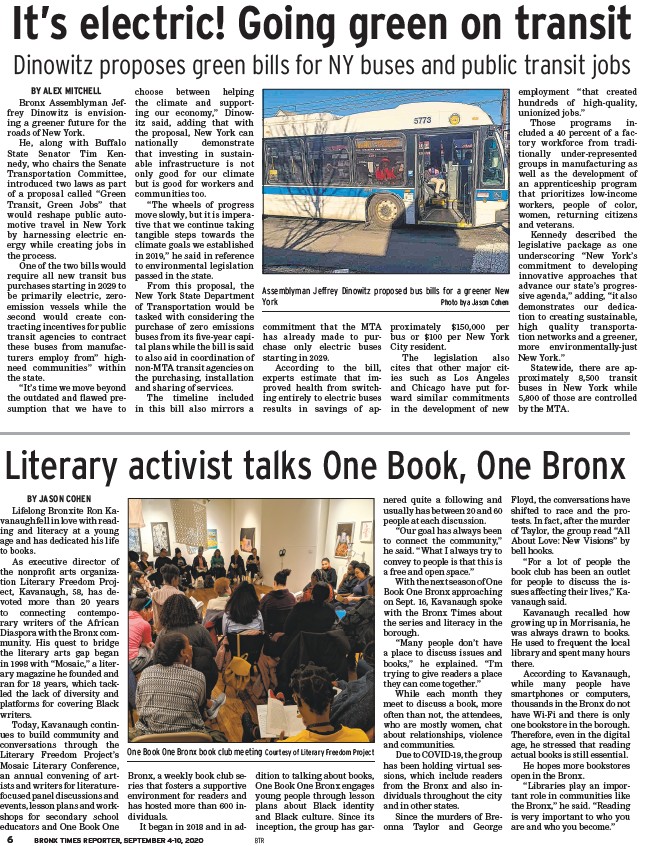
It’s electric! Going green on transit
Dinowitz proposes green bills for NY buses and public transit jobs
BY ALEX MITCHELL
Bronx Assemblyman Jeffrey
Dinowitz is envisioning
a greener future for the
roads of New York.
He, along with Buffalo
State Senator Tim Kennedy,
who chairs the Senate
Transportation Committee,
introduced two laws as part
of a proposal called “Green
Transit, Green Jobs” that
would reshape public automotive
travel in New York
by harnessing electric energy
while creating jobs in
the process.
One of the two bills would
require all new transit bus
purchases starting in 2029 to
be primarily electric, zeroemission
vessels while the
second would create contracting
incentives for public
transit agencies to contract
these buses from manufacturers
employ from” highneed
communities” within
the state.
“It’s time we move beyond
the outdated and fl awed presumption
that we have to
choose between helping
the climate and supporting
our economy,” Dinowitz
said, adding that with
the proposal, New York can
nationally demonstrate
that investing in sustainable
infrastructure is not
only good for our climate
but is good for workers and
communities too.
“The wheels of progress
move slowly, but it is imperative
that we continue taking
tangible steps towards the
climate goals we established
in 2019,” he said in reference
to environmental legislation
passed in the state.
From this proposal, the
New York State Department
of Transportation would be
tasked with considering the
purchase of zero emissions
buses from its fi ve-year capital
plans while the bill is said
to also aid in coordination of
non-MTA transit agencies on
the purchasing, installation
and sharing of services.
The timeline included
in this bill also mirrors a
commitment that the MTA
has already made to purchase
Literary activist talks One Book, One Bronx
BRONX TIMES REPORTER,6 SEPTEMBER 4-10, 2020 BTR
only electric buses
starting in 2029.
According to the bill,
experts estimate that improved
health from switching
entirely to electric buses
results in savings of approximately
$150,000 per
bus or $100 per New York
City resident.
The legislation also
cites that other major cities
such as Los Angeles
and Chicago have put forward
similar commitments
in the development of new
employment “that created
hundreds of high-quality,
unionized jobs.”
Those programs included
a 40 percent of a factory
workforce from traditionally
under-represented
groups in manufacturing as
well as the development of
an apprenticeship program
that prioritizes low-income
workers, people of color,
women, returning citizens
and veterans.
Kennedy described the
legislative package as one
underscoring “New York’s
commitment to developing
innovative approaches that
advance our state’s progressive
agenda,” adding, “it also
demonstrates our dedication
to creating sustainable,
high quality transportation
networks and a greener,
more environmentally-just
New York.”
Statewide, there are approximately
8,500 transit
buses in New York while
5,800 of those are controlled
by the MTA.
Assemblyman Jeffrey Dinowitz proposed bus bills for a greener New
York Photo bya Jason Cohen
BY JASON COHEN
Lifelong Bronxite Ron Kavanaugh
fell in love with reading
and literacy at a young
age and has dedicated his life
to books.
As executive director of
the nonprofi t arts organization
Literary Freedom Project,
Kavanaugh, 58, has devoted
more than 20 years
to connecting contemporary
writers of the African
Diaspora with the Bronx community.
His quest to bridge
the literary arts gap began
in 1998 with “Mosaic,” a literary
magazine he founded and
ran for 18 years, which tackled
the lack of diversity and
platforms for covering Black
writers.
Today, Kavanaugh continues
to build community and
conversations through the
Literary Freedom Project’s
Mosaic Literary Conference,
an annual convening of artists
and writers for literaturefocused
panel discussions and
events, lesson plans and workshops
for secondary school
educators and One Book One
Bronx, a weekly book club series
that fosters a supportive
environment for readers and
has hosted more than 600 individuals.
It began in 2018 and in addition
to talking about books,
One Book One Bronx engages
young people through lesson
plans about Black identity
and Black culture. Since its
inception, the group has garnered
quite a following and
usually has between 20 and 60
people at each discussion.
“Our goal has always been
to connect the community,”
he said. “What I always try to
convey to people is that this is
a free and open space.”
With the next season of One
Book One Bronx approaching
on Sept. 16, Kavanaugh spoke
with the Bronx Times about
the series and literacy in the
borough.
“Many people don’t have
a place to discuss issues and
books,” he explained. “I’m
trying to give readers a place
they can come together.”
While each month they
meet to discuss a book, more
often than not, the attendees,
who are mostly women, chat
about relationships, violence
and communities.
Due to COVID-19, the group
has been holding virtual sessions,
which include readers
from the Bronx and also individuals
throughout the city
and in other states.
Since the murders of Breonna
Taylor and George
Floyd, the conversations have
shifted to race and the protests.
In fact, after the murder
of Taylor, the group read “All
About Love: New Visions” by
bell hooks.
“For a lot of people the
book club has been an outlet
for people to discuss the issues
affecting their lives,” Kavanaugh
said.
Kavanaugh recalled how
growing up in Morrisania, he
was always drawn to books.
He used to frequent the local
library and spent many hours
there.
According to Kavanaugh,
while many people have
smartphones or computers,
thousands in the Bronx do not
have Wi-Fi and there is only
one bookstore in the borough.
Therefore, even in the digital
age, he stressed that reading
actual books is still essential.
He hopes more bookstores
open in the Bronx.
“Libraries play an important
role in communities like
the Bronx,” he said. “Reading
is very important to who you
are and who you become.”
One Book One Bronx book club meeting Courtesy of Literary Freedom Project